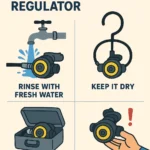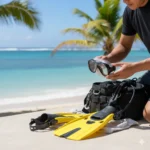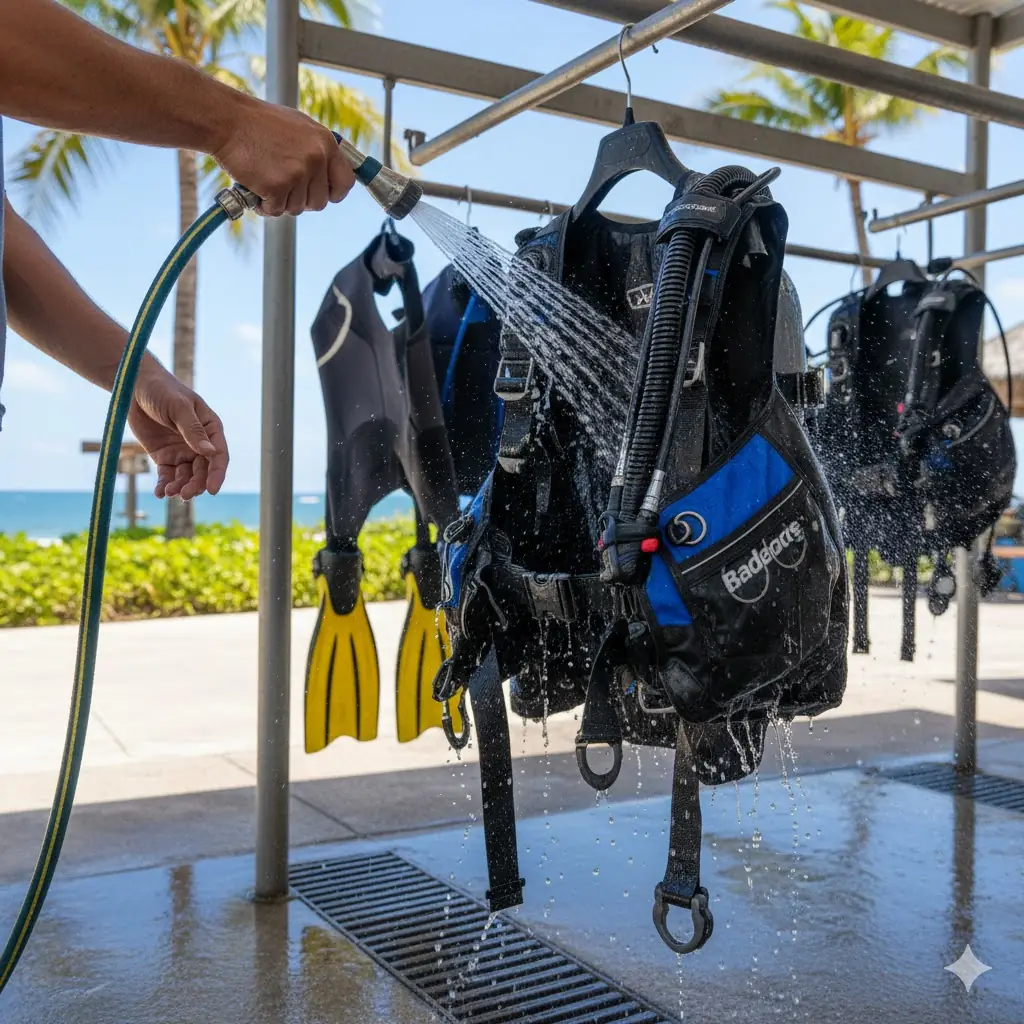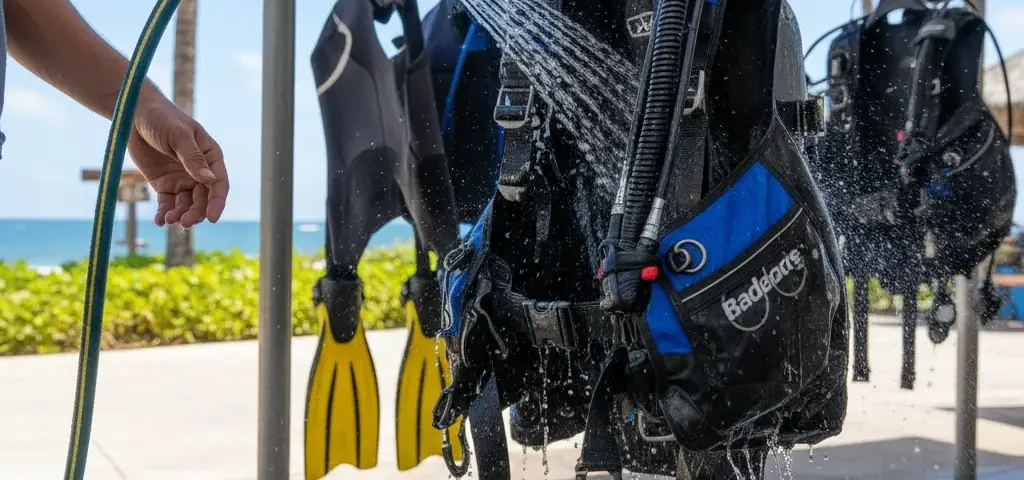
How to Take Care of Your Scuba Regulator
October 9, 2025
The Ultimate Scuba Gear Maintenance Checklist Before and After Diving
October 9, 2025🪸 How to Take Care of Your Scuba BCD
Your Buoyancy Control Device (BCD) is essential for comfortable, safe diving — it controls buoyancy at depth and keeps you stable at the surface. Proper cleaning, inspection, and storage keep your BCD working reliably and extend its service life. This guide explains immediate after-dive care, routine checks, professional servicing, storage, travel tips, and a simple checklist you can copy into your regulator/BCD bag.
Quick Overview
Good BCD care = reliable buoyancy + longer lifespan. Rinse inside and out after every dive, clean gently when needed, inspect valves and straps regularly, and have a certified technician service your BCD at least once a year or per manufacturer recommendations.
Immediate After-Dive Care (Every Dive)
- Rinse the exterior: Use fresh water to remove salt, sand, and sunscreen. Wipe buckles and straps to prevent grit buildup.
- Flush the bladder: Fill the bladder partially using the low-pressure inflator (or pour fresh water through the oral inflator), shake gently, then open the dump valves to drain. Repeat until water runs clear.
- Operate all dumps & inflators: While rinsing, actuate the inflator, oral inflator, and dump valves to flush internal passages.
- Rinse hardware: Pay attention to metal parts like D-rings and stainless steel components — rinse and dry to prevent corrosion.
- Final drying: Partially inflate the BCD (about one-third) and hang it in shade to air-dry. Avoid direct sunlight and hot environments.
Daily / Trip Maintenance
- Check straps, cam bands, and buckles for wear or salt deposits; rinse and dry after each day of diving.
- Inspect the inflator hose and low-pressure connections for cracks or soft spots.
- Ensure the dump valves seal properly — press and release to confirm smooth operation.
- Wipe inner and outer surfaces to remove any sticky residue from sunscreen or insect repellent.
Monthly Checks
- Visually inspect bladder for abrasions, soft spots, or discoloration.
- Check all seams and stitching for separation or fraying.
- Confirm dump valves and oral inflator O-rings are intact — replace O-rings showing cracks or flattening.
- Verify inflator hose clamps are tight and not rusted; replace clamps if corroded.
Annual / Professional Service
A certified BCD service should be performed annually or per the manufacturer's interval. Typical service includes:
- Full inspection and testing of bladder integrity
- Servicing or replacement of inflator assemblies and dump valves
- Replacement of worn O-rings, hoses, and hardware where required
- Pressure/leak testing and functional checks
- Cleaning and lubrication of moving parts with manufacturer-approved products
Service interval guideline: at least once every 12 months or sooner if you dive frequently, in polluted water, or in harsh conditions.
Proper Storage
- Store partially inflated in a cool, dry place away from direct sunlight and chemicals.
- Hang the BCD by the shoulders or lay flat — avoid folding tightly or placing heavy items on it.
- Ensure the BCD is completely dry inside and out before long-term storage to prevent mold and corrosion.
- Keep inflator hoses detached and secured to avoid stress on fittings during storage.
What to Avoid
- Do not use bleach, strong detergents, or petroleum-based cleaners — they can damage fabric and valves.
- Never store the BCD fully deflated and folded for long periods — bladders can stick and seams can crease.
- Avoid prolonged exposure to direct sunlight or heat (e.g., inside a car boot) which degrades materials.
- Do not attempt internal repairs of inflator assemblies or dump valves unless you are trained — leave these to certified technicians.
Travel & Transport Tips
- Use a padded BCD bag for flights and road travel — protect purge valves and inflator assemblies from impact.
- Deflate slightly but keep some air to retain bladder shape during transport.
- If checking in BCD as luggage, cushion it with clothes and keep small parts (O-rings, clips) in a labeled pouch.
- When flying with tanks, follow airline regulations — usually tanks must be empty and valves protected; consult the airline before travel.
Simple Home Cleaning Checklist
- Rinse exterior with a gentle stream of fresh water.
- Flush bladder through the oral or low-pressure inflator until clear.
- Actuate dump valves and inflator during rinse to clear internal passages.
- Rinse buckles, pockets, and straps; remove debris from zipper teeth if present.
- Partially inflate and hang to dry in the shade.
- Store in a padded bag once fully dry.
Troubleshooting — Common Issues & Quick Actions
- Bladder not holding air: Perform a simple bladder leak test (partially inflate and note loss of air). If it leaks, mark it and take for professional repair.
- Inflator sticking or slow: Rinse and exercise the inflator. If sticky persists, do not force it — get it serviced.
- Dump valve leaking: Inspect the valve seat and O-ring; if cleaning doesn’t help, replace the valve or seek technician help.
- Broken buckle or zipper: Replace hardware promptly — do not rely on tape or temporary fixes when diving.
Recommended Items to Keep in Your BCD Kit
- Spare dump valve or small replacement parts (model-specific)
- O-ring & small repair kit (model sizes)
- Soft brush and mild BCD cleaner
- Microfiber cloths
- Small zip-lock bag with service tag and last service date



